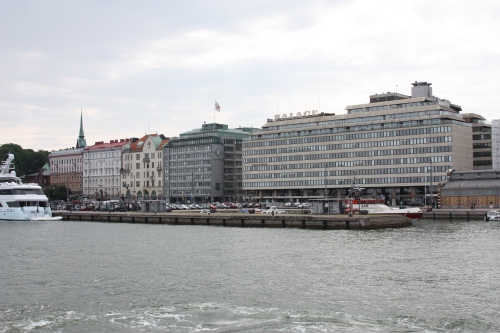Today The Usual (Helsingin Sanomat) waxes excited and naive about the power of the Guggenheim Foundation’s winning competition entry for improving [sic] Helsinki’s South Harbour.
Ankeasta satama-alueesta on nyt mahdollisuus loihtia ainutlaatuinen, kuhiseva satama, joka houkuttelee niin kaupunkilaisia kuin turisteja. Siksi Helsingin ja valtion päättäjien kannattaa käydä läpi Guggenheim Helsinki -hankkeen taloudelliset ja kulttuuriset vaikutukset sekä uskaltaa tehdä päätöksiä.
[And our translation] The grim harbour area can now be conjured up into a unique, teeming port that attracts citizens as well as tourists. That is why Helsinki and the state would be well advised to go through the Guggenheim Helsinki’s economic and cultural impacts, as well as to dare make decisions.
Quite.
One big flaw in their argument is that the South Harbour is not broken. (See above or come and see for yourself in case it is soon broken).
The desire to “fix” this wonderful place comes from a well known source. The business-friendly ideology that produces all the rubbish novelty that has already turned our home planet into “pile of filth” (as the Pope put it last week) but calls it progress.
More like urbanicide.
The Eteläranta site temporarily set aside by the city for the Guggenheim currently works as a ferry terminal forecourt. It’s not the waterfront boulevard of which the editorial writers dream. But it is functional. Its adverse impact on traffic is manageable. Its ambiance is that of real life, real people doing real things.
OK, most of it is car park, but compared to the nuisance of the proposed winning design, it is benign in the extreme.
And yet, all we hear from the nation’s biggest newspaper and city leaders is how this all needs to be made better. The improvement rhetoric is overwhelming. It seeks to persuade us that all people want is pretty and safe custom-built spaces for standard-issue, non-stop, surprise-free (and no doubt begger-free) entertainment. For loitering suitable for homo neoliberalis.
The phrase “entertainment-security complex” comes to mind.
Well, the harbour does have a bit of a problem. Europe’s smallest and most pointless waterfront ferris-wheel went up on the Katajanokka site on the other side of the water. But theoretically it can at least be dismantled and something more appropriate built on the site.
Next to the Eteläranta site is also the old Palace hotel. This jewel of modernism was not exactly loved when it went up in 1951 to accommodate Olympics tourists. But since then, Viljo Revell’s and Keijo Petäjä’s sleek lines have housed hotel guests and business leaders not to mention fashion shows and become part of our collective memory. And since then Helsinki residents have also come to breathe easily around its restrained elegance, which adds to, rather than takes away, the richness I call my home town.
Sadly and mysteriously hotel operations in the building ceased in 2009.
Even more mysteriously, the editorial in today’s Usual ponders on how fabulous it would be if international hotel chains were to come here in the wake of the Guggenheim.
Perhaps they believe magic is better when it’s imported.



 The text is just a fragment, but is it a stain on public space? Is its author perhaps achieving something by making us think again about the (missing) text? (more than who…?)
The text is just a fragment, but is it a stain on public space? Is its author perhaps achieving something by making us think again about the (missing) text? (more than who…?)


 I wonder if this nifty little trucks was shovelling snow off the streets last winter? Here it is on a summer outing behind/in front of the Finlandia Hall. The entrance to this building is curiously tucked away, hugging the earth, and you don’t even really know which is front, which is back. Which is just as well, since the landscape around may yet alter what we think of as the primary entrance.
I wonder if this nifty little trucks was shovelling snow off the streets last winter? Here it is on a summer outing behind/in front of the Finlandia Hall. The entrance to this building is curiously tucked away, hugging the earth, and you don’t even really know which is front, which is back. Which is just as well, since the landscape around may yet alter what we think of as the primary entrance.






 The port of Helsinki closed down harbour functions here some while ago and what we have left is largely disused building or car-parking space. So perhaps it is time to move on from the port’s understanding (see
The port of Helsinki closed down harbour functions here some while ago and what we have left is largely disused building or car-parking space. So perhaps it is time to move on from the port’s understanding (see 